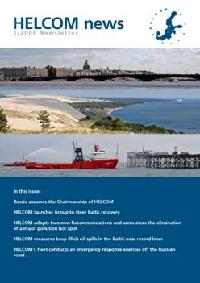Press release
Latest issue of HELCOM Newsletter released
 Helsinki, 28 November (HELCOM Information Service) – The Helsinki Commission has released the latest issue of its newsletter, HELCOM News (No. 2/2008), featuring an overview of latest activities to protect the Baltic marine environment from all sources of pollution and to ensure the safety of navigation. It also includes an update on the current trends in the Baltic marine environment.
Helsinki, 28 November (HELCOM Information Service) – The Helsinki Commission has released the latest issue of its newsletter, HELCOM News (No. 2/2008), featuring an overview of latest activities to protect the Baltic marine environment from all sources of pollution and to ensure the safety of navigation. It also includes an update on the current trends in the Baltic marine environment.
The top stories focus on the launch of the ambitious HELCOM Baltic Sea Action Plan to drastically reduce pollution to the marine environment and restore its good ecological status by 2021. Several articles provide an insight into the first activities that HELCOM is undertaking to implement the plan, including the elaboration of a comprehensive list of municipal wastewater treatment plants and a list of agricultural pollution hot spots that do not fulfill the HELCOM requirements. This task is considered absolutely critical for the successful implementation of the action plan. Inadequately treated sewage and agricultural run-off are the major sources of nitrogen and phosphorus inputs into the Baltic Sea. Therefore, mitigation of excessive nutrient loads from these sources is recognised as one of the priority actions. The newsletter also features an overview of the Third Stakeholder Conference on the Baltic Sea Action Plan, as well as the Stakeholder Workshops on the regional/national implementation of the specific segments of the plan which where held this year.
The beginning of the implementation process coincided with the Russian Chairmanship of HELCOM which began on 1 July 2008. In his article, the new HELCOM Chairman, Mr. Igor I. Maydanov, has indicated that Russia strongly supports the Baltic Sea Action Plan, considering it as a joint initiative of the highest political importance for the Baltic Sea. He stresses that under the Russian Chairmanship, one of HELCOM’s main tasks over the next two years will be to pro-actively get all interested stakeholders involved in dialogues at the regional and Pan-European levels to provide permanent political support to achieve the plan’s environmental goals, and to mobilise the necessary resources.
The 40-page newsletter also includes the latest information on the effects of the excessive nitrogen and phosphorous loads that are responsible for the eutrophication of the marine environment. One of the stories contributed by Swedish experts from SMHI provides an assessment of cyanobacteria blooms in 2008. This year the cool and windy weather held back the formation of mats during the entire season, but all recent studies indicate that eutrophication is far from being curbed. An article by German researchers describes the current situation with the inflows of saline water from the North Sea, as well as the oxygen depletion in the bottom areas. Additionally, Finnish researchers provide results of their survey in the Northern Baltic, which shows a considerable increase in the numbers of the voracious comb jelly from North America, a recently introduced to the Baltic invasive species that poses a serious threat to local fish stocks.
This issue of the HELCOM newsletter also provides latest statistics on illegal oil discharges. Several stories re-cap other important HELCOM events, which occurred in 2008. Among them - the annual exercise of the HELCOM response fleet off Kaliningrad, Russia, CEPCO surveillance flights, the recovery of a pollution Hot Spot near St. Petersburg, as well as the launch of HELCOM Fisheries and Environmental Forum.
To view the PDF version of HELCOM news issue 2/2008, click here.
To order your free print copy, please call the HELCOM Secretariat: + 358 (0)207 412 649 or send an e-mail to info@helcom.fi. More details of HELCOM’s activities, publications and projects are available at http://www.helcom.fi.
Note to Editors:
The Baltic Marine Environment Protection Commission, usually referred to as the Helsinki Commission (HELCOM), is an intergovernmental organisation of the nine Baltic Sea coastal countries and the European Community working to protect the marine environment of the Baltic Sea from all sources of pollution and to ensure safety of navigation in the region.
HELCOM is the governing body of the "Convention on the Protection of the Marine Environment of the Baltic Sea Area," more usually known as the Helsinki Convention.
For more information, please contact:
Mr. Nikolay Vlasov
Information Secretary
HELCOM
Tel: +358 (0)207 412 635
Fax: +358 (0)207 412 639
E-mail: nikolay.vlasov@helcom.fi

